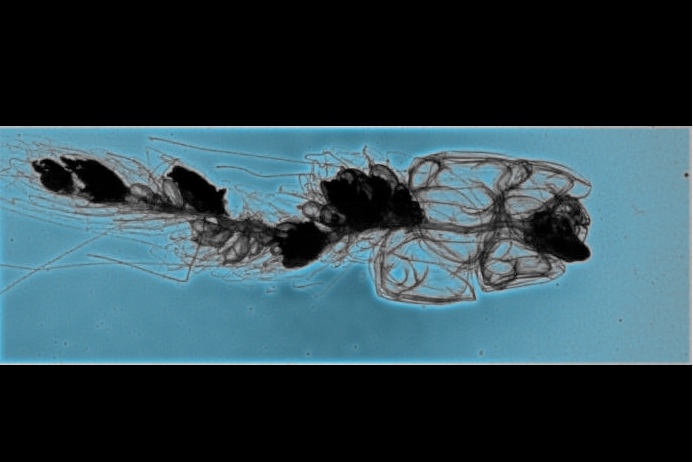Tiny 'Jellyfish' Team Up for Multi-Jetpack Swimming

A jellyfishlike creature that swims using an array of "jetpacks" could transform the way engineers design underwater exploration vehicles, suggests a recent study.
Meet Nanomia bijuga, a relative of jellies, anemones and corals. This siphonophore navigates the ocean in colonies measuring about 12 inches (30 centimeters) long. Most of that length is made up of its tentacles, which trail behind a translucent structure resembling chains of tiny jellyfish attached to a central column. From tip to tentacles, each section within a colony is a specialized group of genetically identical individuals that perform different jobs.
The jelly chains, or clusters of spheres called nectophores, are the designated drivers. And researchers just discovered that they divide the labor based on age, with the young'uns in the front steering, while the elders in the back thrust the gelatinous bus forward. Working together, they form a living propulsion unit that is rare in animals. [Video: Watch the Jelly Creature Using Its Propulsion System]
Gotta jet
Each nectophore sphere produces a propulsion jet, much like its larger jellyfish cousins. But unlike single-jet jellyfish, a colony can have as many as a dozen jets propelling it wherever it wants to go.
And it needs them; colonies typically migrate more than 500 feet daily, traveling from deep ocean waters to the surface where they feed at night. Nectophores do all the work, though they make up only a fraction of the colony's mass. The study's authors compare their efforts to an adult human running a daily marathon, while dragging another person behind them.
The multiple jets also allow the colony to "turn on a dime," said study co-author Kelly Sutherland of the University of Oregon. By coordinating when each jet pulses, N. bijuga can execute precision maneuvers that leave single-jet swimmers bobbing in its wake. [See Amazing Photos of Jellyfish Swarms]
Sign up for the Live Science daily newsletter now
Get the world’s most fascinating discoveries delivered straight to your inbox.
To track the jets' pulses, Sutherland and colleagues needed to see how they disturbed the water. They built custom tanks for sample colonies, adding floating particles that could be illuminated by laser light. When the N. bijuga colonies fired their jets, scientists captured the particles' motion with high-speed cameras shooting 1,000 frames per second.
It takes a colony
And the colonies didn’t disappoint, exhibiting a wide range of maneuvers. Nectophores pulsed alone and in pairs, synching along one side of the cluster's column or all working together. The colony's twists and turns were controlled by jets turning on and off to quickly change direction.
Even if one of the nectophores detached, which can happen when the colony is disturbed, the rest picked up the slack. "The others eventually realign themselves to fill the gap, and there is no loss in swimming capability," Sutherland told Live Science.
The study also found that a nectophore's age and size determined its role in the colony's propulsion. Nectophores form as buds — clones of the first individual in the cluster. New buds emerge at the colony's tip, nudging older and larger nectophores down toward the tentacles. The bigger the nectophore, the longer and more powerful its thrust, so the biggest individuals at the end of the cluster produced the strongest jets, driving the colony's forward momentum.
But the younger, smaller nectophores controlled the steering. Frequent pulses from their weak jets kept the colony on course. And their position at the front of the swimming engine allowed carefully timed pulses to pivot the entire colony.
N. bijuga’s array of fixed jet streams pulsing at different strengths differs from most human-engineered systems, which rely on jets that swivel to change direction. The study's authors suggest that modeling aquatic vehicles after N. bijuga colonies could be a more efficient solution.
"It's a quite sophisticated design," lead author John Costello of Providence College in Rhode Island, said in a statement. “The colony has evolved to control relatively simple, stable components using a more complex control system.”
Still, much about N. bijuga colonies remains unknown; how fast they grow, how big they can get, even how long they live. But this study marks an important step toward understanding the complex communication that coordinates their daily swimming marathons.
"I think that we're at the beginning of working [out] some of these questions about how the individuals within a colony interact," Costello told Live Science.
The findings are detailed in Nature Communications.
Follow us @livescience, Facebook & Google+. Original article on LiveScience.

Mindy Weisberger is an editor at Scholastic and a former Live Science channel editor and senior writer. She has reported on general science, covering climate change, paleontology, biology and space. Mindy studied film at Columbia University; prior to Live Science she produced, wrote and directed media for the American Museum of Natural History in New York City. Her videos about dinosaurs, astrophysics, biodiversity and evolution appear in museums and science centers worldwide, earning awards such as the CINE Golden Eagle and the Communicator Award of Excellence. Her writing has also appeared in Scientific American, The Washington Post and How It Works Magazine. Her book "Rise of the Zombie Bugs: The Surprising Science of Parasitic Mind Control" will be published in spring 2025 by Johns Hopkins University Press.









